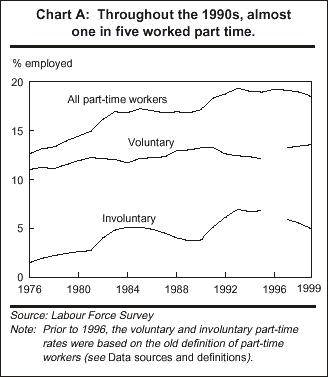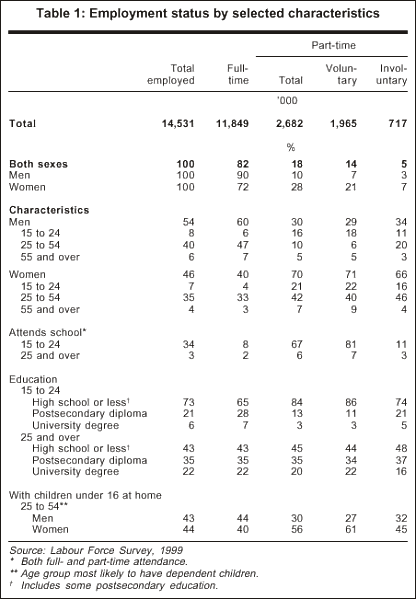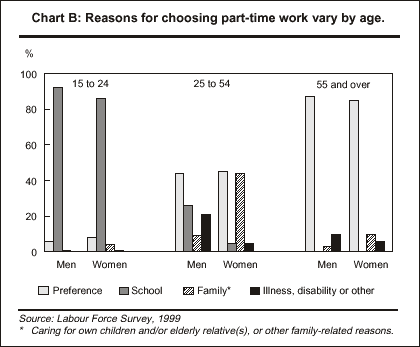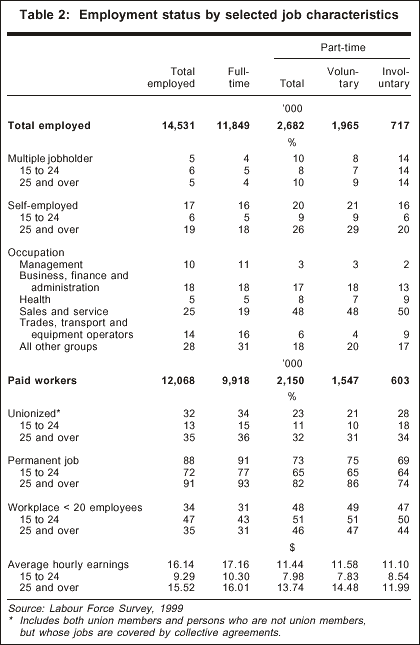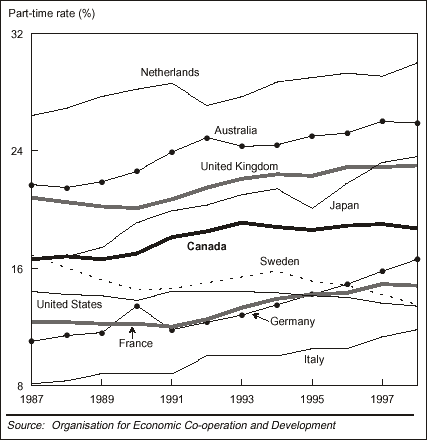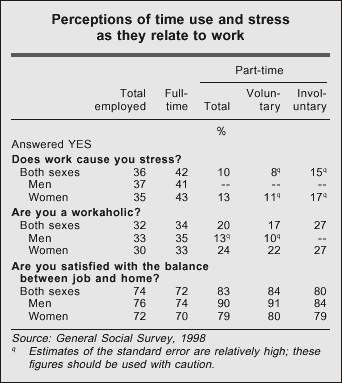
75-001-XIE

 |
November 2000 Vol. 1, no. 2 |
Part-time by choice
Over the past three decades part-time employment has grown steadily. With almost one in five workers putting in less than 30 hours per week at his or her main job, part-time labour has become a major form of non-standard work. As a consequence, ongoing issues surrounding part-time work, such as job quality, security, pay, and benefits, have become more important than ever.
Although the part-time employment rate decreased slightly in the late 1990s, the proportion of part-timers who willingly engaged in such work and did not want full-time work, increased. Consequently, the proportion of involuntary part-time workers—those who would prefer full-time work—has decreased (Akyeampong, forthcoming). This study looks at those who voluntarily work part time, as well as their reasons for doing so, their levels of work-related stress, and their job characteristics (see Data sources and definitions). Comparisons are made with full-time and involuntary part-time workers. The article begins with an overview of the growth in part-time work.
An upward trend
The percentage of workers employed part time grew from 12.6% (1.2 million) in 1976 to 18.5% (2.7 million) in 1999 (Chart A). This trend is not unique to Canada, as part-time work has increased in most industrialized countries (see International comparisons). One-third of the net increase in the part-time employment rate since the late 1980s can be attributed to employment increases in industries with already high rates of part-time work (see Decomposing changes in part-time employment). However, the more important factor has been an overall trend toward increased part-time work across all industries.
A number of well-known, sometimes interrelated, factors are thought to be behind the widespread increase in the use of part-time work. One is the development of a more globally competitive service-based economy. Since the evolving economy has brought technological change to the workplace, extended operating and production schedules, and increased fluctuations in business activities, firms have been inclined to use more part-time labour (Tilly, 1991). Employers have embraced a more contingent, flexible workforce for cost-saving reasons as well: "In a climate of increased competition, employers sought to reduce their labour costs and increase their workforce flexibility by decreasing their core full-time, permanent workers and hiring more workers on a part-time basis" (Schellenberg, 1997).
Some of the increase in part-time employment may also have come from the supply side, as more workers are looking for flexibility and ways to balance their home and work lives. Indeed, the percentage of part-timers who have adopted this work arrangement voluntarily has recently increased, reaching 73% in 1999, up from 69% in 1997. ![]() 1
1
Finally, demographic change can also contribute, as proportional increases or decreases in populations with high part-time rates, such as youths, can affect overall part-time rates. Analysis of this factor actually shows a dampening effect on the part-time work rate (see Decomposing changes in part-time employment), offsetting the effects of industrial employment shifts and the overall trend toward part-time work.
Youths and women predominate in voluntary part-time work
The number of voluntary part-time workers reached 2 million in 1999, representing 14% of all employment and 73% of all part-time employment (Table 1). These workers were most often aged 15 to 24 (40%) or women between 25 and 54 (40%). Respective figures for full-time workers were 10% and 33%. Youths and women aged 25 to 54 also made up the majority of involuntary part-time workers (73%). However, compared with their voluntary counterparts, involuntary part-time workers were more likely to be core-age adults (25 to 54)—65% versus 46%—attesting to their greater preference for full-time work.
The skewed demographic distribution of voluntary part-time workers is better understood when education and family characteristics are examined. For example, 81% of young voluntary part-time workers were attending school, compared with only 8% of youths working full time and 11% of youths working involuntarily at part-time jobs. This finding accords with the main reason given by both young men and women for working part time: roughly 90% of youths did so in order to attend school.
Consequently, since so many voluntary part-time workers are still young and attending school, their average level of education is lower than that of full-time or involuntary part-time workers. For example, 86% of voluntary part-time workers aged 15 to 24 in 1999 had a high school education or less, compared with only 65% of full-time workers. However, once people reach age 25 and have completed most of their schooling, full-time and voluntary part-time workers have strikingly similar levels of education—higher than that of most involuntary part-time workers (22% were university graduates, versus 16%).
Roughly 4 out of 10 men and women with full-time jobs, aged 25 to 54, had at least one child under 16 at home. This is in stark contrast to voluntary part-time workers, in whose case 61% of women and only 27% of men had dependent children at home. These differing rates are not surprising, given that 35% of women voluntarily working part time reported doing so in order to care for their children. Only 4% of men gave this reason. loyment between 1987 and 1999.
Reasons for choosing part-time over full-time
The Labour Force Survey asks all "voluntary part-time workers" the main reason for not wanting full-time work (see Data sources and definitions). The reasons given for choosing part-time work vary substantially by age. In 1999, most youths said school attendance was their main reason for working part time (92% of men and 86% of women), while older workers (aged 55 and over) stated personal preference (87% of men and 85% of women) (Chart B). Older workers choosing to work part time are most likely doing so to ease into retirement. On the other hand, 25-to-54 year-olds tended to report a variety of reasons, which differed by sex. Although personal preference for part-time work was the main reason for both men and women (44% and 45%, respectively), family responsibilities were almost as common a reason for women (44%) and going to school was a strong second for men (26%). Only 6% of women in this group were attending school.
Job security and earnings: voluntary part-timers in the middle
In terms of holding down more than one job, voluntary part-time workers in 1999 had a rate closer to that of full-time workers (8% versus 4%) than to that of involuntary part-time workers (14%) (Table 2). This is a reasonable finding given that the latter would prefer to have full-time work, and multiple jobholding brings them closer to that goal.
Self-employment was much more common among voluntary part-time workers (29% of those 25 and over) than among either full-time (18%) or involuntary part-time workers (20%). The desire to work part time may be one reason some people move into self-employment, as it allows greater flexibility and control over work hours.
Half of all part-time jobs, both voluntary and involuntary, were in sales and service, compared with only 19% of full-time jobs. (Sales and service positions are often scheduled outside 9-to-5 hours, thus creating a need for more short-hour work schedules.) On the other hand, 11% of full-time employment was found in management occupations, compared with just 3% of part-time work.
Rates of unionization and job permanence were higher for older than younger workers, as were those for full-time workers. For example, 36% of full-time workers aged 25 and over were in a unionized job, compared with 31% of voluntary and 34% of involuntary part-time workers. Proportions of workers with permanent jobs were more varied: 93% of full-time workers, 86% of voluntary and 74% of involuntary part-time workers. Similarly, average hourly earnings were highest for full-time workers aged 25 and over ($16.01), second highest for voluntary part-time workers ($14.48), and lowest for involuntary part-time workers ($11.99). Not only were job security and wage rates higher for voluntary (compared with involuntary) part-time workers, but work-related stress tended to be lower for this group (see Work stress).
Summary
The growth in part-time work has made it an important factor in the workplace. In 1999, almost one in five workers spent less than 30 hours per week at his or her main job. Furthermore, whether out of personal choice or to accommodate personal circumstances, such as the wish to attend school or to care for young children, 73% of part-time workers would rather have been engaged part time than full time. Although voluntary part-time workers fare better than their involuntary counterparts, their wages and job security are still below those of full-time workers.
International comparisonsGiven the growing importance of part-time work, the Organisation for Economic Co-operation and Development (OECD) has recently begun to provide international comparisons. It defines part-time workers as persons who usually work less than 30 hours per week in their main job (OECD, 1997). (This definition is similar to Canada's.) Accordingly, from 1987 to 1998 part-time employment increased in 8 of 10 selected OECD countries. Only 2 countries showed a decrease: the United States (down from 14.4% to 13.4%) and Sweden (down from 16.9% to 13.5%). Part-time employment rates were particularly high in Australia, Japan, the Netherlands and the United Kingdom, where approximately one in four workers put in less than 30 hours per week in 1998. Relative to other OECD countries, at just under 20%, Canada's part-time employment rate was "middle-of-the-road." |
Decomposing changes in part-time employment
The increase in the part-time employment rate can be attributed to shifts in industry or demographic structure and/or to a trend toward part-time labour as a work arrangement. Part-time work may be growing because industries that usually offer this option are growing more, or because all industries are seeing an increase. Or both explanations may be true. Shift-share analysis Demographic shifts over the period had a dampening effect on the part-time employment rate, mainly because of the proportional decrease in the youth population. Had this not been the case, the part-time rate might have increased by as much as 2.6% (instead of 1.7%), owing to the growing trend to part-time work among both men and women (except women 25 to 54). |
Work stressThe 1998 General Social Survey on Time Use asked respondents a number of questions about their use of time in relation to paid work. Findings show that volume of work (part-time or full-time) goes a long way in explaining the differences in perception of work-related stress. Roughly 4 out of 10 full-time workers (men and women) said that work caused them stress, compared with just one out of 10 part-time workers. Furthermore, one-third of all full-time workers believed themselves to be "workaholics," compared with one-fifth of part-time workers. Women working part time were more likely to make this observation than men (24% versus 13%), and involuntary part-timers more so than voluntary (27% versus 17%). A greater proportion of women working part time were older and thus more likely to be married and have children, factors that tend to increase financial and time-related pressures. The majority of full-time workers were satisfied with the balance between their job and home life: 74% of men and 70% of women. Not surprisingly, working part time increased the degree of satisfaction, with 91% of men and 80% of women reporting contentment with the balance between home and work. |
Data sources and definitionsThe Labour Force Survey (LFS) is a monthly household survey that collects information on labour market activity from all persons 15 years and over, including questions about the usual and actual weekly hours a person contributes to his or her main, and any other, job. The core content of the 1998 General Social Survey (GSS) was time use. From January to December, roughly 11,000 respondents were asked a number of questions relating to time use. The questionnaire included a time-use diary, a child-care diary for respondents with children under 15 at home, a section on perceptions of time, and one on unpaid help and volunteering. For more information on this cycle of the GSS, contact Manon DeClos at (613) 951-9298. Labour force statistics from the Organisation for Economic Co-operation and Development (OECD) come from its annual questionnaire, and from a number of national sources such as yearbooks. The OECD also uses data from the Statistical Office of the European Union (Eurostat) and the International Labour Office (ILO). Usual hours: the number of paid hours an employee usually works per week. For the self-employed, it refers to the number of hours usually worked in a typical week, regardless of whether they were paid. Part-time employment: persons who usually work less than 30 hours per week at their main or only job. Prior to 1996, part-time work was based on the total hours of all jobs. The revised definition increased the total number of part-time workers. The historical data of the LFS have been revised to reflect the current definition. However, the full-time workers who were reclassified to part-time had not been asked the reason for working part time. Therefore, the voluntary and involuntary part-time rates prior to 1996 are based on the old definition of part-time workers. Voluntary part-time employment: persons who usually work less than 30 hours per week, and who state they do not want to work full time. These workers are then asked the main reason for not wanting full-time work. This could be own illness or disability, caring for own children, caring for elderly relative(s), other personal or family responsibilities, going to school, personal preference, or other. The label of "voluntary" part-time worker can be ambiguous. Although everyone in this category has made the decision to work part time, less than half cite personal preference for this arrangement. In most cases respondents give personal circumstances, such as care of children or going to school, as the reason for "choosing" to work part time. Some may feel that part-time work is not an ideal arrangement but the only option given their life circumstances, while others may view it as preferable, despite having chosen it for other reasons. Overall, the "personal preference" category made the largest gain over three years—up from 34% in 1997 to 36% in 1999. The largest increase was among the 25-to-54 age group, up from 42% to 45%. The growth in part-time as a preferred work arrangement is probably the main reason for the overall increase in the voluntary part-time employment rate. Involuntary part-time employment: persons who usually work less than 30 hours per week but state they would prefer to work full time. These workers are asked the main reason for not having full-time work, and whether or not they have searched for full-time work (Akyeampong, forthcoming). |
Notes
- Prior to 1996, the voluntary and involuntary part-time rates were based on the old definition of part-time workers (see Data sources and definitions).
- In simplified terms, the shift-share technique estimates the increase in the part-time work rate by separately holding each factor constant over the time period. For example, if the employment distribution by industry had remained the same from 1987 to 1999, what would changes to the part-time rate have been, and similarly, if the part-time rate had been constant over the time period, what would the altered employment levels have done to the part-time rate?
-
The two factors, employment share and trend to work part time, are decomposed and expressed in the following formula:
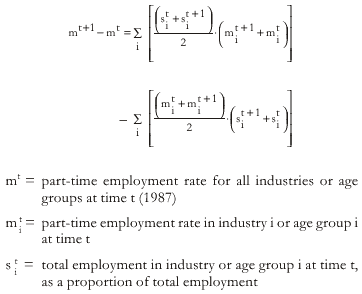
References
- Akyeampong, E. B. "Involuntary part-time workers." Perspectives on Labour and Income (Statistics Canada, Catalogue no. 75-001-XPE), forthcoming.
- Organisation for Economic Co-operation and Development. Labour Force Statistics, 1978-1998. Paris: OECD, 1999.
- ---. The Definition of Part-time Work for the Purpose of International Comparisons. Labour Market and Social Policy Occasional Papers, no. 22. Paris: OECD, 1997.
- Schellenberg, G. The Changing Nature of Part-time Work. Social Research Series, Paper no. 4. Ottawa: Canadian Council on Social Development, 1997.
- Tilly, C. "Reasons for the continuing growth of part-time employment." Monthly Labor Review (March 1991): 10-18.
Author
Katherine Marshall is with the Labour and Household Surveys Analysis Division. She can be reached at (613) 951-6890 or marskat@statcan.gc.ca.
|
|
|
|
|
[ Highlights ] [ Main menu | Editor's corner | More news | Contact us | Survey information | Back issues ] [ Statistics Canada home page | In depth | Français ] |
|
© Statistics Canada - Conditions of use |
